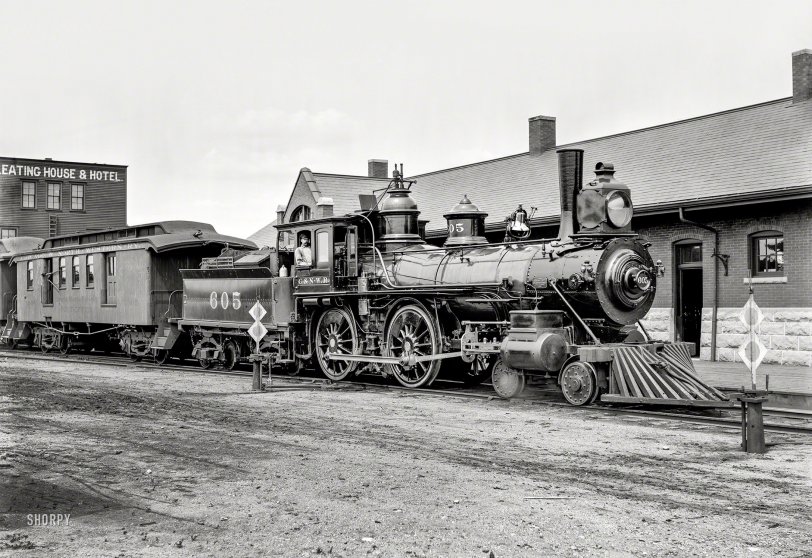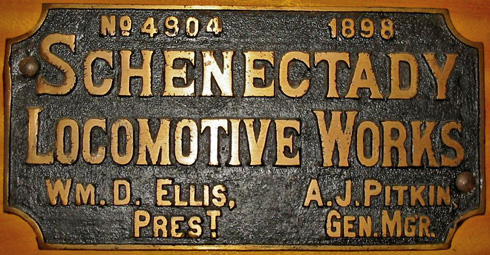


Framed or unframed, desk size to sofa size, printed by us in Arizona and Alabama since 2007. Explore now.
Shorpy is funded by you. Patreon contributors get an ad-free experience.
Learn more.

- Details, Details
- What's that building to the left of the tower?
- Coal Barges
- Bromo-Seltzer
- Inner harbor
- The Basin
- What a headache!
- Giant stepladder?
- Baldwin 62303
- Baldwin VO-1000
- Cold
- No expense spared
- Tough Guys
- Lost in Toyland
- And without gloves
- If I were a blindfolded time traveler
- Smoke Consumer Also Cooks
- Oh that stove!
- Possibly still there?
- What?!?
- $100 Reward
- Freeze Frame
- Texas Flyer wanted
- Just a Year Too Soon
- WWII -- Replacing men with women at the railroad crossing.
- Yes, Icing
- You kids drive me nuts!
- NOT An Easy Job
- I wonder
- Just add window boxes
Print Emporium
South Dakota Division: 1899

Circa 1899. "Tracy, Minnesota -- engine of the South Dakota division, Chicago & North-Western R.R." Detroit Publishing glass negative. View full size.
Second career for a C&NW C-2 4-4-0 - can you help?
At least one of these C&NW C-2 class locomotives was sold secondhand. I have a large B&W print of Sheffield & Tionesta #4 at Kelletville, PA in 1904, with no visible builders plate, but "C&NW" cast in the smokebox door just as in 605. S&T #4 was used between 1904 and 1914 as the primary passenger engine on the little S&T, and was replaced by a new Baldwin 4-4-0. The entire railroad was abandoned and sold for scrap in 1941.
Judging by the matching set of dents on the air compressor on the photo I have taken from the same angle, I seriously thought S&T 4 was C&NW 605. If there's any information anyone can find on which one it was, contact me.
Sheffield & Tionesta is convered in the book "Teddy Collins Empire" (Casler, 1974) of the "Logging Railroads of Pennsylvania" series. His book is out of print but the railroad museum of PA has the negatives and original manuscript.
Finding this particular image on Shorpy was wonderful and made me a member.
Jug
I wonder what beverage was contained in the earthenware jug aft of the engineer.
A Work In Progress
Whoever was doing the sprucing up must not have had time to finish the tender before the engine was needed for service, because the old, dull finish is visible around and inside its numbers, and on the curved gangway area where the crew climbs up to board.
Builder's engine Data
C&NW 605 was built by Schenectady Locomotive Works in 1885. C&NW labelled it C-2 class. Boiler pressure was 150 lbs. Driving wheels were 63 inches diameter. 605 was scrapped March 5, 1917. 605 weighed 88,500 pounds. Tractive effort was 16,900 lbs. Looks from my source that the railroad had only a dozen C-2 class engines.
Pressed paper wheels
> I don't know how to recognize it in railroad wheels, but it is certainly true pressed paper was used in some, with an iron "tire" on the rim.
The give-away is the bolts/rivets on the leading truck wheels. These are typical of composite wheels. A cast wheel would not need these bolts/rivets to hold it together.
I could be wrong but
I bet it has that new locomotive smell.
During World War Two plastic-reinforced jettisonable paper fuel tanks were used to extend the range of fighter aircraft including the P-47, P-51 and P-38. The largest held 200 gallons, which gave (for example) the P-47 close to a couple more hours of flying time, enough to escort our bombers over Germany. This ability was a very significant contributor to winning the air war because enemy fighters no longer could easily attack the big and unprotected B-17s and B-24s, unprotected except for their many .50 caliber machine guns (some B-17s packed 11 or more), which made many enemy pilots moribund.
Not Paper
The pressed paper hubs were strictly used on Pullman Sleepers after
the inventor showed George that they really did reduce vibration transmission.
In case of fire
Check out the fire escape on the side of the hotel in the background.It doesn't look too fireproof itself!
Magnificent Locomotive!
And it's obviously being maintained by a crew that really cares about it. As Olde Buck implies, it is probably not new -- in 1899, the 4-4-0 layout was already considered classic if not obsolescent, and the pin connectors, notoriously dangerous, were being replaced by the "modern" type of couplers. Note the brightly polished bell, the shining surface of the boiler, and other authentic details -- you can see the whistle on top of the steam dome and the lever that triggers it with a lanyard leading back to the cab. The sand dome shows the plumbing that deposits sand on the fore driver wheel as needed for traction.
I don't know how to recognize it in railroad wheels, but it is certainly true pressed paper was used in some, with an iron "tire" on the rim. In the 1880's, pressed paper was even used for the skins of racing shells, as it was lighter than wood. I don't think it is used today for any structural purposes.
Actually, locos were kept this clean 'back in the day'
>Looks so new it must still have the price sticker on the window.
Although it's possible this was recently out-shopped, it's much more likely it came fresh from the roundhouse. Back in the 19th century, locomotives were kept in pristine condition; railroads hired people to wipe them down and engineers took particular pride in the appearance of their engines.
Olde Buck points out this was most likely converted from wood to coal, I'd guess this loco was constructed in the early 1880s and converted in the late 1880s/1890s.
Note the fixture for a steam line on the roof of the baggage/mail car and the corresponding rig on the back of the tender. There's a steam feed from the steam dome (alongside the whistle). I think this was probably added to the original locomotive.
There's a 'mail bag catcher' on the door for mailbags. I think we've had previous Shorpy photos showing the mail bag hangers alongside a passenger depot.
Schenectady Locomotive Works
that manufactured C&NW engine #605 operated from 1848 until it merged into American Locomotive Company in 1901. One of the engines it manufactured for C&NW (#1015 in 1900) is still in existence at the Museum of Transportion in Kirkwood, MO.

Pressed Paper?
Solidly in the link and pin era, the front shank coupler announces this is pre-1900 when such couplers were finally banned.Note the "door" hinged to the side of the headlight. When waiting in a siding, the fireboy went out on the pilot to close the door on the lit headlight so as not to blind the approaching train. This was actually easier than turning out the oil or acetylene lamp. I've seen roller shades used here most often; I can't recall seeing a hinged door before...eh, but those CNW guys could be funny.
Note the headlight mounts are left over from the short smokebox of the engine's original arrangement.Directly below the headlight on the boiler front are two brackets; these were most likely used to brace a pilot-mounted snowplow, necessary equipment in the Plains.
You can almost read the builder's plate date and shop number, but she was built by Schenectady Locomotive Works. Lastly, the front wheels are made of...get this...pressed paper.Look it up, I ain't fibbing![pressed paper railroad wheel]
Number 605
Looks so new it must still have the price sticker on the window. Magnificient detail.
























On Shorpy:
Today’s Top 5